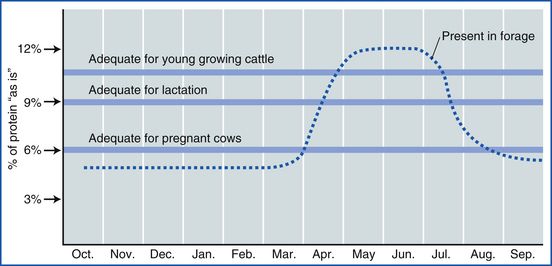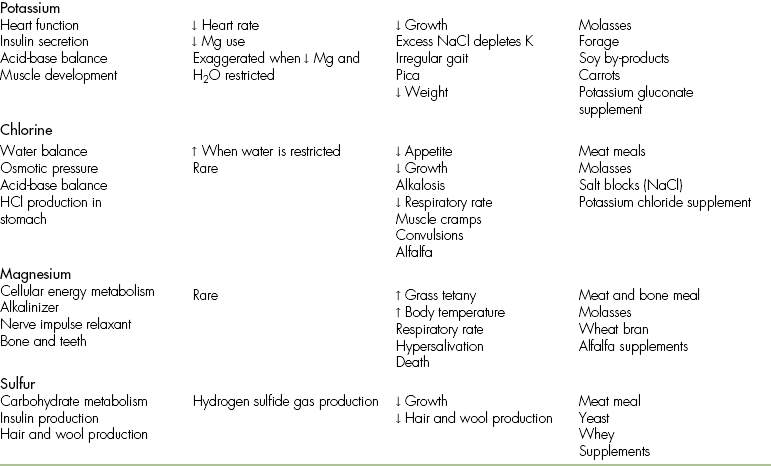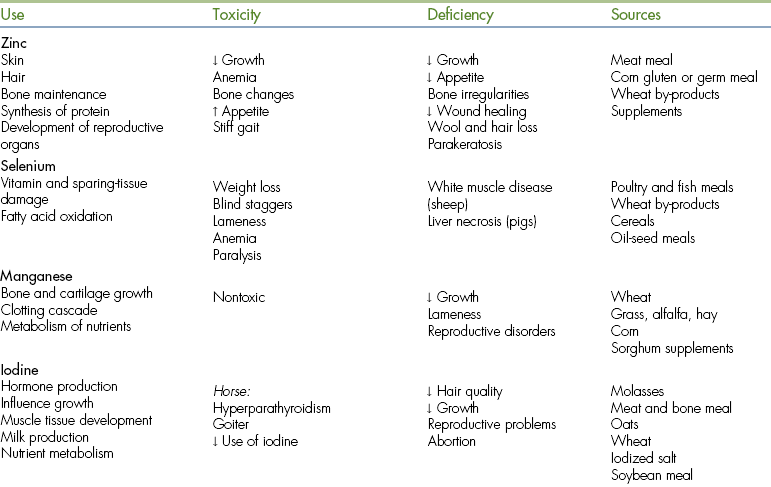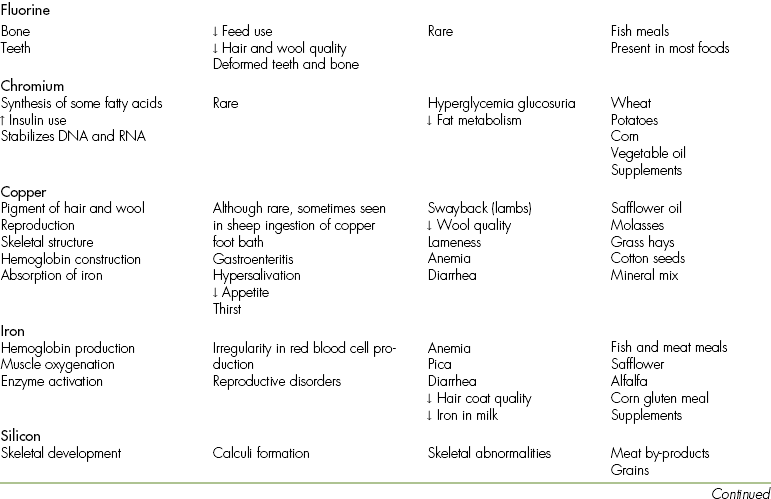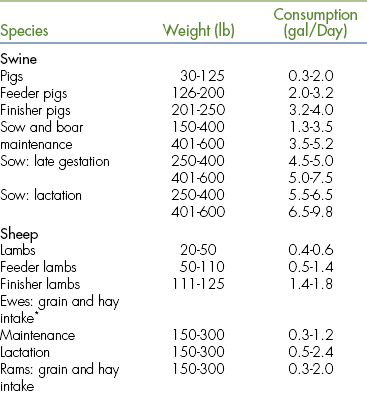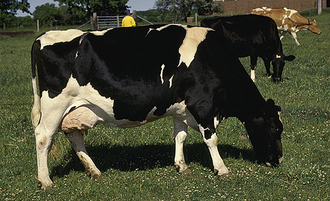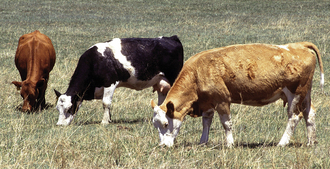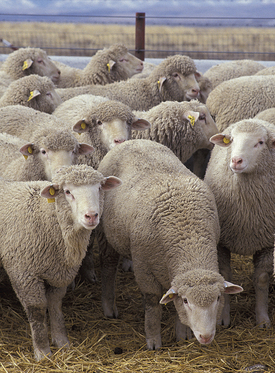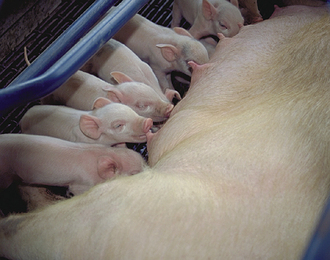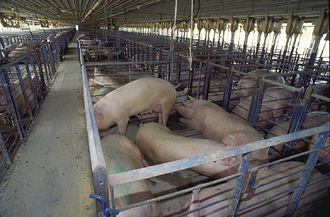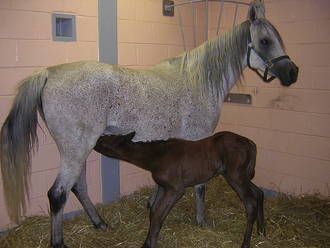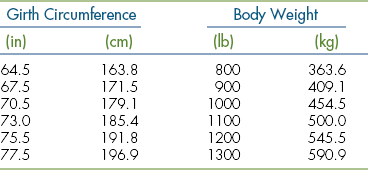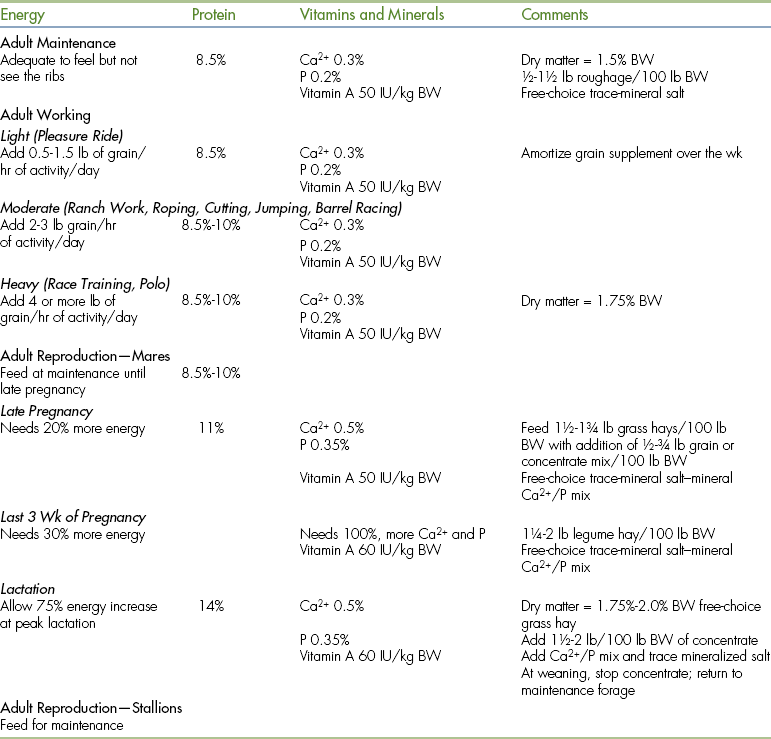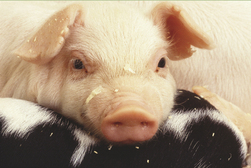
Large Animal Nutrition
When you have completed this chapter, you will be able to:
1 Explain the relationship between productivity and profitability in livestock production.
2 List the energy-producing and nonenergy-producing components of food.
3 Define the following terms: digestion, maintenance nutrient requirements, biologic value, protein efficiency ratio, total digestible nutrients, gross energy, digestible energy, metabolizable energy, and net energy.
4 List the variables affecting energy requirements of livestock and factors affecting the water intake of livestock.
5 Differentiate between essential and nonessential amino acids.
6 Explain the importance of water in metabolic reactions.
7 Differentiate between microminerals and macrominerals and give examples of each.
8 Describe the two commonly used feeding systems for dairy cattle.
9 Describe special considerations for feeding beef cattle, sheep, and swine for specific productive purposes (maintenance, growth, finishing, lactation, work, wool, or eggs).
10 List advantages and disadvantages of pasture feeding of livestock.
NUTRIENTS
Nutrients are ingested to support life. Livestock producers and horse owners want to obtain the most desirable results from the nutrients their animals consume at an economical rate and with an advantageous financial return. Ingested nutrients are either retained by the animal or excreted in the urine and feces. Retained nutrients are used for a wide array of body functions, such as homeostasis, replenishment and development of tissues, reproduction, and milk, wool, and meat production.
Maintenance nutrient requirements (MNRs) are the levels of nutrients needed to sustain body weight without gain or loss (Box 13-1). The MNR is the minimal level of dietary need; usually the vast percentage of published requirements is higher than this standard. As a general rule, one half of consumed and absorbed nutrients are used to fulfill MNRs. Individual variation results in fluctuation from this standard; be sure to evaluate need against all information to achieve the most accurate results.
Feeding standards are available listing the amounts of nutrients required by different species for specific productive purposes, such as maintenance, growth, finishing, lactation, work, wool, or eggs. The most widely used feeding standards in the United States are those published by the National Research Council (NRC), and they are established for beef cattle, dairy cattle, sheep, goats, swine, poultry, and horses (see Recommended Reading). Periodically the feeding standards are updated and published by a committee appointed by the NRC.
Digestion (the process of protein, carbohydrate, and fat breakdown into absorbable nutrients) is accomplished by both chemical and physical methods. It is essential to remember that it is not the alfalfa hay, corn, or oats that is actually used by the cells of animals, but rather the digested and absorbed nutrients, such as amino acids, sugars, fatty acids, minerals, and vitamins, that present at the cellular level. The quality, quantity, and cost of nutrients that can be provided by the feedstuff are of primary importance when choosing ingredients for farm-animal feeding.
PROTEIN
Protein is the principal constituent of organs and soft tissues. It is constructed of building blocks called amino acids that are linked together in a chain. The arrangement of amino acids in the chain and the length of the chain are two factors that help to determine the composition of the protein. There are 10 essential and 12 nonessential amino acids. Essential amino acids must be supplied in the diet because the animal body cannot synthesize them fast enough to meet its requirement. Amino acids consist of nitrogen, carbon, oxygen, and sulfur. The deconstruction or deamination process releases these elements into the body’s system and results in either their elimination from the body or their use as energy.
Animal feed (Box 13-2) is identified often by crude protein content, but the measurement rarely illustrates the quality or use potential of the protein. A feed can possess a high protein content, yet the biologic value of that protein is low. Protein biologic value is the percentage of true absorbed protein that is available for productive body functions. Conceptually, it is the “amino acid grade card” because it defines the available amino acids. In general, proteins of animal origin have greater biologic value than do proteins of plant origin. The higher the biologic value, the better the protein used for productive purposes. Protein quality is also measured as the protein efficiency ratio, which is the number of grams of body weight gain per unit of protein consumed (McDonald, 1995).
Animal and plant proteins vary greatly in their distribution of amino acids and biologic value. When combined in correct proportions with other protein (e.g., animal protein), protein that individually has very poor biologic value (e.g., corn) may yield a biologic value similar to that of a single high-quality protein. The quality of protein depends on disallowing the overprocessing of feed, overheating in storage, and form of the feed (Nash, 1985) (Figure 13-1).
Use by Ruminants
Rumen digestion facilitated by microbes has the ability to convert most feed protein into peptides and amino acids, many of which are further degraded into ammonia, organic acids, and carbon dioxide. The ammonia released on microbial degradation of feed protein will be removed from the rumen by absorption through the rumen wall or used by the microorganisms for synthesis of microbial protein. Microbial protein synthesis by the microorganisms results in a fairly constant protein quality supply to the lower digestive tract. The protein quality from moderate to poor feed will usually be improved by rumen metabolism, whereas the opposite may occur with high-quality protein feed. The rumen microbes also have the ability to convert nonprotein nitrogen sources into microbial protein. Typical nonprotein nitrogen sources include urea, ammonium salts, ammoniated by-products, or free amino acids and are best used judiciously because an excess or an imbalanced intake can be toxic (Church, 1984).
FATS
Fats provide dietary energy; serve as a source of heat, insulation, and protection for the animal body; and provide essential fatty acids. Fat has 2.25 times more energy per gram than protein or carbohydrates. Fats also aid the absorption of fat-soluble vitamins. Linoleic, linolenic, and arachidonic fatty acids are considered essential, even though linoleic acid is capable of being converted to arachidonic acid. However, the process to make these conversions is arduous and inefficient, and as such, arachidonic acid should be considered conditionally essential (McDonald, 1995).
CARBOHYDRATES
Carbohydrates (Box 13-3) are the primary energy source in livestock rations. They are less expensive and more readily available than protein or fat. Most feedstuffs of plant origin are high in carbohydrate content, especially cereal grains. Carbohydrates must be broken down into simple sugars for absorption from the digestive system. This requires digestive enzymes generated by the host or by microflora inhabiting the digestive system of the host. The carbohydrate-splitting enzymes are effective in splitting most complex carbohydrates into simple sugars except those with the beta linkage, as found in cellulose (fiber). Microflora in the rumen of ruminants and the cecum of some nonruminants, such as the horse or rabbit, produce an enzyme so that these species can use fiber for energy. Carbohydrates are commonly categorized into animal feed as concentrates (grains, high-starch compounds) and forage (grass, hays, legumes). There are no minimum or maximum requirements for carbohydrates; rather, intake is defined in conjunction with energy need.
Feedstuff Energy
The largest function of feed is to provide energy for body processes. Total digestible nutrients (TDN), gross energy (GE), digestible energy (DE), metabolizable energy (ME), and net energy (NE) are all different measures of feed energy value.
TDN is a general measure of the nutritive value of a feed. Digestibility coefficients are used to compute the content of TDN. The usefulness of TDN as a measure of feed energy is limited in that it does not take into account energy losses in urine, combustible gases, and heat. The discrepancies can be large for forage-based feed because they tend to overestimate the energy available for productive purposes. TDN is expressed as a percentage of the ration or in units of weight and not as an actual caloric number.
Gross energy (GE) is the total energy (Box 13-4) potentially available in a feed consumed by an animal. All energy values used in the following scheme are expressed in kilocalories (kcal) or megacalories (Mcal) per unit of weight. During digestion and absorption, a portion of the GE escapes the body in the form of undigested food residue in the feces. Subtraction of the energy lost in the feces from the consumed GE accounts for energy that was digested and absorbed, or digestible energy (DE). The measurement of DE uses the same elements as TDN and gives similar energy values to feed. DE values and TDN are used extensively in horse feed. Energy that is digested and absorbed by the body is not used with 100% efficiency; a portion of the absorbed energy is lost in the urine and as combustible gases. Accounting for these energy losses leads to a step beyond DE or TDN, metabolizable energy (ME). The energy values for ME are used widely in the formulation of swine and poultry feed. One further refinement in this energy scheme is accounting for heat lost from the body during metabolism of the nutrients. Net energy (NE) represents the actual portion of energy available to the animal for use in maintaining body tissues or during pregnancy or lactation. NE values are used extensively in the beef, dairy, and sheep industry.
MINERALS AND VITAMINS
Minerals and vitamins are needed in small amounts compared with other nutrients, but play integral roles in many metabolic processes. Minerals are divided into two categories: microminerals and macrominerals (Box 13-5). The list of minerals and vitamins and their functions are given in Tables 13-2 to 13-4.
WATER
Water is the cheapest and most abundant nutrient. It makes up 65% to 85% of an animal’s body weight at birth and 45% to 60% of body weight at maturity. Water is derived metabolically from the breakdown of organic nutrients in the animal tissues or drinking water or obtained from foodstuffs. Because water is the largest constituent of the animal, deprivation of water of only a few percentages of body weight is life threatening. Clean, fresh water should be readily available to maintain a zero water balance (Table 13-5).
DAIRY CATTLE
The dairy industry is successfully using many different production systems. Systems are based on geographic area and feedstuff availability. The traditional pasture system continues to be used in areas with readily available land, whereas dry-lot systems are more popular in urban and suburban areas (Figure 13-2).
Regardless of the dairy production system, two feeding programs are most frequently employed. Total mixed ration (TMR) is the practice of weighing and blending all feedstuffs into a complete ration. Each bite consumed by the cow contains all of the required levels of nutrients. The other program is a forage and grain diet fed separately. The animals are provided hay free choice at all times, silage is offered once or twice per day, and feed concentrates are fed twice daily.
Feeding, more than any other single factor, determines the productivity of lactating dairy cows. Feed represents about 50% of the total cost of milk production. Therefore a good feeding program is necessary for profitable milk production. Nutrient requirements for lactation are large and often several times the MNR (Figure 13-3 and Tables 13-6 to 13-8). Water is also important for dairy cows (Boxes 13-6 and 13-7).
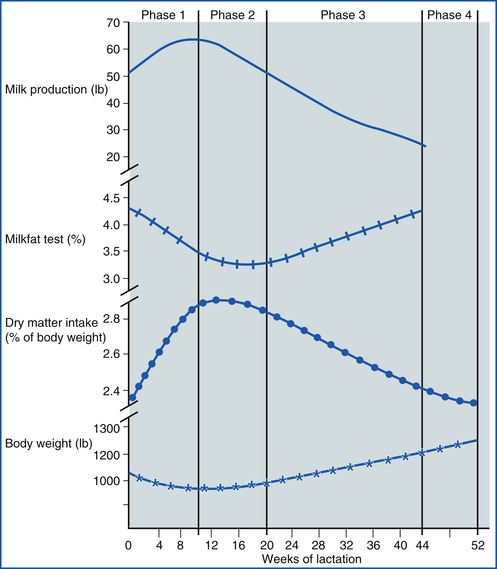
FIGURE 13-3 Milk production varies during a typical 52-week production phase. Disparity is also observed in milk fat content, dry-matter intake requirements, and body weight.
Energy
Carbohydrates (forage, concentrate) are the major energy source for lactation, followed by fats and proteins. Carbohydrates constitute 50% to 80% of energy on a dry-matter basis of much of the forage and many grains. Forage possesses a significant fiber content that is broken down by the microbial population in the rumen and used as energy.
Although the rumen capacity of the dairy cow is considerable, she cannot eat sufficient forage to meet her extensive nutrient needs during lactation. The estimated daily intake for forage is based on body weight and forage quality. A guide for estimating the consumption of forage (dry-matter basis) fed on a free-choice basis is in Box 13-8 and Table 13-9.
TABLE 13-6
Daily Feeding Considerations in Developing Female Dairy Cattle∗

∗Ranges shown in table are to be used as guidelines, recognizing that variations can occur as a result of breed, milk production levels, butter fat content, rate of gain, and lactation cycle.
†Net energy (NE) expressed in megacalories (Mcal).
‡Ca2+/phosphorus ratio needs to be maintained from 0.43%-0.66%; levels above 0.95%-100% can result in decreased performance and metabolic abnormalities.
TABLE 13-7
Daily Guidelines for Lactating Dairy Cows∗
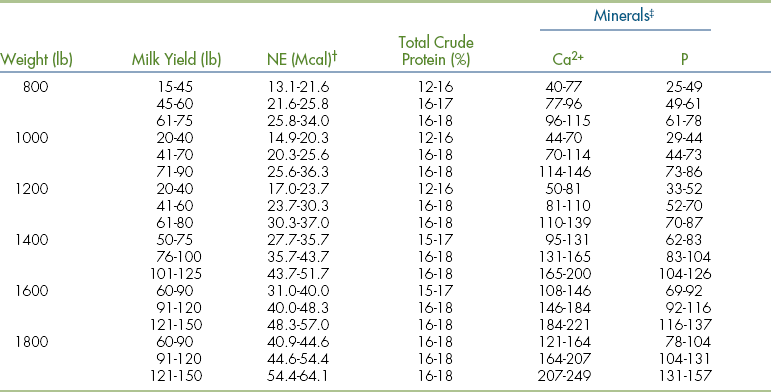
∗This table is designed to be used only as a guideline. Feed to maintain body condition. Table assumes a 4% milk fat content of lactation.
†Net energy (NE) measured in megacalories (Mcal).
‡Mineral values assume that balance has been established. Variations occur with breed, lactation phase, milk yield, and age.
TABLE 13-8
Daily Nutrient Considerations for Dairy Cattle∗

∗Ranges shown in table are to be used as guidelines, recognizing that variations can occur because of milk production levels, butter fat content, rate of gain, and lactation cycle.
†Metabolizable energy (ME) measured in megacalories (Mcal).
‡Ca2+/phosphorus ratio needs to be maintained from 0.43%-0.66%; levels above 0.95%-100% can result in decreased performance and metabolic abnormalities.
TABLE 13-9
| Forage Quality | Daily Intake (% Body Weight) |
| Excellent | 3.0 |
| Good | 2.5 |
| Average | 2.0 |
| Fair | 1.5 |
| Poor | 1.0 |
If cows are allowed to consume all the forage they want, they will not have sufficient rumen capacity to consume enough concentrate to meet the energy requirements for lactation. In general, most dairy farmers try to feed forage at a rate of 1.75% of body weight. The concentrate fed with the forage will vary with the kind of forage offered (a high-protein concentrate will be needed with a low-protein forage) and the availability and cost of the feedstuffs. The concentrate provides more energy and usually is higher in protein than the forage. Fat use varies with age, environment, and reproductive status. Fat intake during lactation can be 5% to 6% of the total energy intake. Excessive dietary fat intake can negatively affect rumen microbial activity, depressing fiber use (Shirley, 1986).
Protein
The restriction of protein or energy during lactation can lead to reduced milk production and increased reproductive problems. Protein is supplied by the forage or concentrate and should be added at levels to ensure that minimum protein requirements are met (see Tables 13-6 to 13-8). Protein intake that exceeds the requirement is used as energy at a premium value. Protein is an expensive nutrient and is not an economic source of energy. Most cows are fed a high-protein legume hay, such as alfalfa, and grain, which should supply most or all the protein needs during lactation. Nonprotein nitrogen supplied as urea also can be an effective feedstuff to supply protein equivalents in dairy rations. The use of animal protein sources derived from ruminant species is not allowed in dairy rations to prevent the possible transmission of bovine spongiform encephalopathy (BSE).
Minerals and Vitamins
Milk is composed of 0.7% minerals on a dry-weight basis. The average cow will lactate 140 lb of mineral as a portion of the milk produced per year. A balanced mineral intake is essential; mineral requirements for lactation are given in Tables 13-6 to 13-8.
Rumen microorganisms can synthesize the water-soluble vitamins, whereas vitamin K is the only fat-soluble vitamin readily synthesized by microorganisms. The supplementation of water-soluble vitamins or vitamin K normally is not necessary in rations for ruminants.
Forage of good quality and properly harvested normally contains adequate levels of vitamin E and the precursor of vitamin A, carotene. Vitamin A is stored for extended periods in the body. Vitamin D is synthesized through ultraviolet radiation by the skin or added to a dairy ration as sun-cured forage or a vitamin supplement.
Although water-soluble vitamins are synthesized by the rumen microflora, some evidence indicates that supplemental thiamin, choline, and niacin may be beneficial in cows undergoing heavy stress or various disease states. Daily requirements for vitamins for lactating dairy cows are found in Table 13-8.
DAIRY CALVES
Newborn calves require the mother’s colostrum within the first 72 hours of life to acquire energy and maternal immunity from disease. Peak benefits of colostrum intake are realized within the first 24 hours postpartum. Optimally the first milking colostrum should be given to the calf at 10% to 12% of the calf’s weight with at least one half administered within 4 to 6 hours after birth. Colostrum can be successfully frozen and used at a later date and diluted equally with water should diarrhea occur because of the richness of the colostrum. The initial sucking of the calf will create a bypass of the rumen, allowing the milk to go directly into the abomasum. This ability will decrease as the calf ages and the rumen becomes functional. Calves normally start on milk replacers and then are offered calf starters within the first week of life. Calf-starter rations are commonly fed until about 3 months of age at a rate of 5 to 7 lb of calf starter per day. During the first week of life, a forage source should be added to the diet selection and free-choice water. Calves are typically weaned at 4 to 8 weeks of age and accustomed to solid food.
BEEF CATTLE
Feeding represents almost three fourths of the cost of production of beef cattle (Neumann, 1977). Beef producers control their profitability by obtaining optimal nutrient intake with the least-cost feed formulation. Profitability hinges on the ability to balance the use of resources, such as pasture and feedlot, with the production of high-quality finishing animals generated by the breeding herd. Beef production usually is divided into two primary areas: cow-calf production and finishing cattle.
COW-CALF PRODUCTION
A live calf from each cow each year should be the goal of the profitable cow-calf producer. Nutrition has a large impact on the beef-breeding herd. Cows gaining weight just before and during the breeding season have a shorter period between calving and the first estrus period and typically have higher conception rates.
Energy
Carbohydrates are the major energy source for beef cows, followed by proteins and fat. Forage commonly fed to beef cows possess a significant fiber content that is broken down by the microbial population in the rumen and used as energy.
Feeding beef cows can be very economic because high-quality forage or pasture can supply all energy needs with no need for energy supplementation from grains or fats (Figure 13-4). In the summer, pasture normally will supply adequate energy for the cow. If pasture is inadequate, supplemental energy should be provided in the form of silage or hay. In the winter, pregnant cows are fed wintering rations (a combination of forage, grain, and a protein source supplemented with vitamins and minerals) to meet energy needs with minimal weight gain (Box 13-9). Cows in good condition are more tolerant to the stresses of winter and require less maintenance energy per unit of weight than do cows in poor condition.
Protein
Most pasture, silage, and forage contain adequate levels of protein to meet the needs of the breeding cow. If low-grade roughage (e.g., cobs, straw, stalks) are fed over extended periods of time, the ration must be supplemented daily with 1 to 1.5 lb of a 35% to 45% crude protein supplement. A review of deficiency and toxicity signs can be found in Boxes 13-10 and 13-11. The use of animal protein sources derived from ruminant species is not allowed in beef-breeding–herd rations. This is to prevent the possible transmission of BSE.
Minerals and Vitamins
Mineral supplementation will be necessary and is usually offered on a free-choice basis when animals are on pasture (Figure 13-5). Trace-mineral salt blocks and granular salt are popular methods of offering minerals and salt to animals on pasture. Good-quality pasture and roughage are adequate in vitamins A and E with ample levels to meet the needs of breeding cows. Supplemental vitamin A should be provided when low-grade roughage or long-stored hays are used as a major source of energy in wintering rations. There are mineral mixes that contain a stabilized form of vitamin A.
CALVES
The basic food for calves consists of the mother’s milk (Box 13-12) plus access to pasture or forage fed to the cows. Many cow-calf producers offer calves a highly palatable creep feed to supply additional nutrients, leading to improved weaning weights and decreased weight loss by nursing cows. Creep-fed calves will weigh an extra 30 to 50 lb by weaning time. The greatest response to creep feeding is found when pasture is inadequate or the quality is poor. Beef calves generally are weaned at 7 to 8 months of age.
FINISHING CATTLE
The finishing of cattle refers to the time in the growth phase of growing cattle when they are fed to produce beef that is desirable to the food consumer. Most finished cattle are between 1 and 2 years of age and weigh more than 1000 lb. The goal of the finishing feeding program is to maintain a maximum feed intake and weight gain without causing digestive upsets (Table 13-10).
TABLE 13-10
Daily Nutrient Considerations for Beef Cattle∗
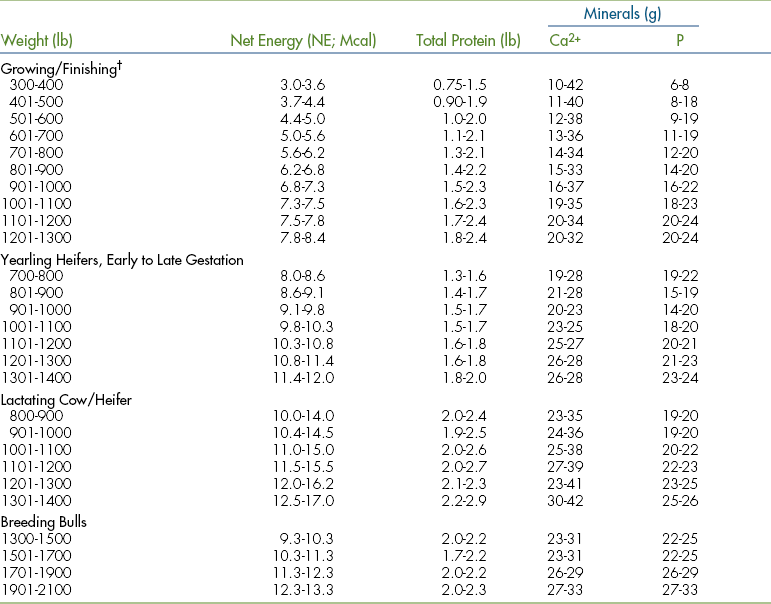
∗Values represent guidelines, and individual variations dictate the constant appraisal of body condition to ensure desirable results.
†Assumes medium- to large-frame steers.
From National Research Council: Nutrient requirements of beef cattle, ed 8, Washington, DC, 1990, National Academic Press.
Energy
High-energy diets are used to increase weight gain, improve the carcass characteristics, and decrease the cost of energy compared with diets high in fiber. Total dry-feed intake commonly will be 2% to 3% of the animal’s body weight. The feed contains high levels of grains to supply readily available energy (Figure 13-6). Cattle fed these rations are more prone to develop digestive upset (rumen acidosis), founder, or liver abscesses and require more attention and management to prevent these problems.
Protein
Protein requirements (9% to 14%) are greatly affected by age, size of animal, and growth rate. Young cattle require higher levels of protein (as a percentage of the diet) than do older cattle. Protein sources cost more than feed grains, but experienced finishing cattle producers know that a protein deficiency is more expensive than a slight protein excess in the ration. When protein is deficient, energy is not well used, and performance suffers.
Supplemental protein for finishing cattle can be provided by natural protein sources or nonprotein nitrogen (e.g., urea). Nonprotein nitrogen sources are used most efficiently by cattle consuming relatively high levels of grain. A normal range of urea intake for many finishing rations is 0.10 to 0.15 lb per animal per day. The use of animal protein sources derived from ruminant species is not allowed in finishing cattle rations to prevent the possible transmission of BSE.
Minerals and Vitamins
Calcium is often added to the high-grain diets fed to finishing cattle. Generally, when forage (especially legumes) constitutes more than 25% of a finishing ration, additional calcium is not required. Grain contains adequate levels of phosphorus to meet the needs of finishing cattle. Finishing rations are balanced to contain a calcium/phosphorus ratio of 2:1 or higher. Salt is added to diets or fed on a free-choice basis to finishing cattle to meet the sodium requirement (Box 13-13). The less forage that is formulated into the diet, the more need there is for trace-mineral supplementation.
High-quality forage contains adequate amounts of vitamin A precursors and vitamin E. Generally, finishing rations are supplemented with 20,000 to 30,000 IU of vitamin A daily because they contain high levels of grain. Vitamins E and D are added to finishing rations when the feed ingredients are devoid of these vitamins or the production practices merit their inclusion (see Table 13-10).
SHEEP
Feeding represents the single largest cost of production for all types of sheep operations. Sheep producers control their revenue by offering feed that supports optimal production, is cost-effective, and minimizes nutrition-related problems. Sheep production is divided into two principal areas: the breeding flock and lamb production.
BREEDING FLOCK
Ewes are the foundation of the sheep operation; they produce lambs and generate wool (Box 13-14). These two cash crops can be influenced greatly by feeding management. The mature ewe (3 to 8 years of age) needs only sufficient feed to maintain her normal weight from the time her lambs were weaned until 15 weeks (21-week gestation) into her next pregnancy, assuming not much weight was lost during lactation. Pasture is adequate to meet her nutrient needs during this period of production (see Figures 13-1 and 13-5 for reviews of the nutrient composition of pasture).
Energy
The energy requirements of the ewe largely depend on the stage of the reproductive cycle (Box 13-15). During the first two thirds of the pregnancy, energy requirements are close to those required for MNRs, and good pasture or hays can supply all the energy needs (Box 13-16). In the last trimester, energy requirements increase, and forage must be supplemented with grains. Poor care during the last trimester of pregnancy leads to lambing problems, lower wool output, and depressed milk production. A common problem attributed to poor nutrition in ewes is lambing paralysis or ketosis. Feeding inadequate forage with little or no grain can create a deficiency of usable carbohydrates during the last trimester of pregnancy in ewes carrying twins or triplets and can lead to paralysis and coma in the mother. Prevention is the least expensive route to avoid pregnancy disease in the breeding flock. Energy requirements are highest during lactation and proportional to the number of lambs the ewe is nursing (Figure 13-7 and Table 13-11).
TABLE 13-11
Daily Nutritional Considerations in Sheep
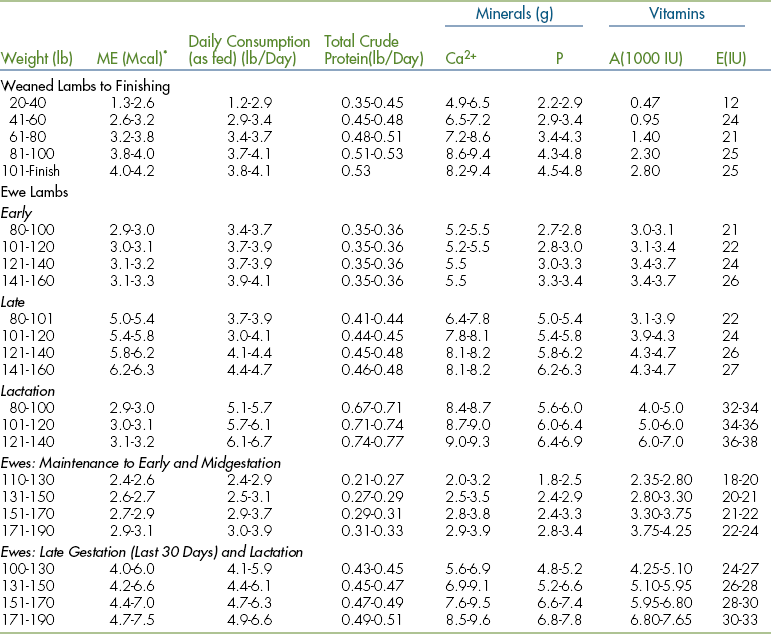
∗ME (metabolizable energy) is measured in megacalories (Mcal); 1 Mcal = 1000 kcal.
Protein
An adequate protein intake ensures good wool production and reproductive function (Box 13-17 and Table 13-11). The most limiting amino acid for the maturation of wool is methionine; protein ingested by the breeding flock must contain adequate levels of this amino acid. Most pasture, silage, and forage contain adequate levels of protein and amino acids to meet the needs of the breeding flock. If low-grade roughage (e.g., cobs, straw, stalks) are fed over extended periods of time, the ration must be supplemented daily with a protein supplement or a nonprotein nitrogen source (Box 13-18). The use of animal protein sources derived from ruminant species is not allowed in ewe rations to prevent the possible transmission of BSE.
Minerals and Vitamins
Trace-mineral salt blocks and granular salt represent popular methods of offering minerals and salt to ewes on pasture. Sheep store copper quite well in various organs and tissues and develop toxicity symptoms to copper more rapidly than other livestock. Care should be taken to prevent exposing sheep to high levels of copper in their trace-mineral source.
Good-quality pasture and roughage are adequate in vitamins A and E with ample levels to meet the needs of the breeding flock. Supplemental vitamin A should be provided when low-grade roughage or long-stored hays are used as a major source of energy in wintering rations (see Table 13-11).
LAMBS
Lambs must be nursed with colostrum milk within the first hour after birth to improve survivability. Colostrum milk provides immunologic protection and energy for the newborn lamb. The lamb must consume at least 6 to 8 oz of colostrum to receive immunologic protection. Lambs are weaned successfully at 8 weeks of age or earlier.
Lambs also can be successfully weaned from their mother at 1 day of age and offered a milk replacer (Box 13-19). They should be weaned from the milk replacer at 3 to 4 weeks of age and transitioned to a high-quality, palatable solid feed. Postweaning rations (until lambs reach 50 lb) should be high-quality protein (16% to 20% crude protein), high energy, and well fortified with vitamins and minerals.
Grower (50 to 85 lb) and finisher (more than 85 lb) rations for lambs are normally formulated to contain 15% to 16% and 13% to 14% protein, respectively. A simple ration of shelled corn, long alfalfa hay, and supplement (protein, calcium, vitamins, trace minerals) can be fed to growing-finishing lambs (Figure 13-8). Research does not clearly indicate the need for vitamin additions to rations for early lambs, but it has become a common practice to fortify the rations with vitamins A, D, and E (see Table 13-11).
Large, fast-growing lambs are susceptible to overeating disease (enterotoxemia), which can cause death. This disease is caused by toxins produced by Clostridium perfringens and appears to be related to overeating by lambs of a ration high in grain. A vaccination with bacterin or toxoid can be used for lambs older than 2 months of age and will virtually eliminate symptoms of overeating disease.
SWINE
The swine industry has changed dramatically over the past 30 years. Most pigs are raised in confinement to reduce labor requirements for the owner and to improve the environment for the animal. The genetic base of the swine industry has changed to a more prolific breeding herd and better-muscled, faster-growing offspring. Feed still constitutes 60% to 70% of the cost of raising swine. Few swine are grazed on pasture; most are fed complete high-grain rations in self-feeders or are limit fed if in the breeding herd. The production of pigs normally is divided into three distinct areas: the breeding herd, starter pigs, and growing-finishing pigs.
BREEDING HERD
For profitable production of swine, the sows must be bred, gestate 114 days, nurse a litter for 21 to 35 days, rebreed within 10 days after weaning, and continue the cycle for five to seven litters. Nutrition plays a key role in allowing this to occur, especially during lactation (Table 13-12).
Energy
After breeding and for the first two thirds of gestation, the energy intake is limited to 6000 to 7000 kcal ME per day. The total amount of feed is increased during the last third of gestation, providing 9000 to 10,000 kcal ME per day, which contributes additional energy to the developing fetuses during this last stage of gestation. Overfeeding energy during gestation has a direct negative impact on the lactation feed intake, which can impair lactation performance.
In lactation, the goal of the swine producer is to encourage as much energy intake by the lactating female as possible (15,000 to 20,000 kcal ME per day). Sows are often fed twice per day to ensure fresh feed and improved energy intakes. Frequently, fat is added to the lactation ration to improve palatability and energy density. Sows peak in milk production between the second and third weeks of lactation, and they should be full fed to support the production of milk. A rule of thumb for feeding lactating sows is to offer 4 to 5 lb of the base ration plus 1 additional pound for every pig nursing (Figure 13-9).
Protein
The protein requirements during gestation are relatively low (11% to 12% crude protein, 0.5 lb of protein per day). The development of the fetuses and reproductive tissue requires small amounts of protein each day.
During lactation, sows require higher levels of protein intake to support milk production (2 to 3 lb of protein per day), which is accomplished by feeding a ration with a higher protein content at a greater intake level. Sows not fed adequate levels of protein or energy during lactation will support milk production with a loss of body tissue stores. Sows can lose more than 100 lb in weight during lactation if not fed proper amounts of energy or protein.
Minerals and Vitamins
Minerals and vitamins need to be supplemented throughout the life of pigs. The breeding herd is normally fed diets fortified with the minerals calcium, phosphorus, salt, zinc, iron, copper, iodine, selenium, and manganese. Calcium and phosphorus are kept in a balance of 1:1 to 2:1 for all stages of production. Low levels of calcium and phosphorus in the breeding-herd rations can lead to fractures and lameness in the female.
Sow’s milk is virtually devoid of iron, and anemia of nursing pigs will occur unless they are supplemented with another source of iron (Box 13-20). The two most common ways to supply additional iron are as follows:
1. Injection of iron (150 to 200 mg) as iron dextran or other iron-carbohydrate complexes at 3 days of age
2. Oral iron solution given at 3 days of age or swabbed onto the dam’s udder several times during lactation
The vitamins supplemented in breeding-herd diets are the fat-soluble vitamins A, D, E, and K and the water-soluble vitamins thiamin, riboflavin, niacin, pantothenic acid, B6, B12, choline, biotin, and folic acid. Adequate additions of these vitamins ensure proper development of the fetus in gestation and milk production in lactation (Box 13-21).
STARTER PIGS
Pigs are commonly weaned at 3 to 5 weeks of age and remain in the starter phase until they weigh 40 to 50 lb (Figure 13-10). The earlier the age at weaning, the more complex is the ration required to help in the transition from mother’s milk to solid food. Starter diets (20% to 24% protein) are very complex and nutrient-dense complete feed and therefore often purchased from a commercial feed manufacturer. The highest-quality ingredients are used to make starter diets and include milk products, fish meal, spray-dried blood products, oats, corn, and fat. Vitamin and mineral supplementation levels are high in starter diets. This feed typically is pelleted and quite costly (see Table 13-12).

FIGURE 13-10 Young pigs need to be kept in a clean, dry, draft-free environment for optimal health and growth.
As the pig ages, the complexity and nutrient density of the starter ration decrease, leading to a lower-cost formula. In the last 2 or 3 weeks of the starter period, crude protein decreases to 18% to 20%, and the diet is often offered as a ground feed.
GROWING-FINISHING PIGS
Growing-finishing diets have been modified to complement the changes in the genetic base of modern swine. The leaner pigs require higher levels of protein and consume less energy than previous generations (see Table 13-12).
Energy
Complete grower-finisher rations are based on cereal grains and frequently have fat added to increase caloric intake. Fibrous feed ingredients often are not used or are used sparingly to prevent depressions in caloric intake. Corn, wheat, sorghum, and barley are the more popular cereal grains used to supply energy and comprise 60% to 85% of the ration.
Protein
Contemporary swine nutrition concentrates not on the protein content of feed, but on the amino acid levels. Lysine typically is the first limiting amino acid in swine formulas. Amino acid levels decrease as a percentage of the diet throughout the growing-finishing phase.
Amino acid levels are matched to muscle growth throughout the growth period to maximize lean tissue growth. Underfeeding of amino acids depresses muscle deposition, and overfeeding amino acids leads to excess, which is costly.
Typical protein sources in growing-finishing diets are soybean meal, meat and bone meal, and synthetic amino acids. When protein sources are expensive, synthetic amino acids can replace a portion of the protein source with no loss in performance. The most commonly available synthetic amino acids are lysine, methionine, threonine, and tryptophan (Figure 13-11).
Minerals and Vitamins
Growing-finishing swine are fed diets fortified with the minerals calcium, phosphorus, salt, zinc, iron, copper, iodine, selenium, and manganese. Calcium and phosphorus are kept in a balance of 1:1 to 2:1 throughout this period. Deficiencies of phosphorus will depress growth performance as the animal grows.
Riboflavin, niacin, pantothenic acid, and vitamin B12 are the water-soluble vitamins most likely to be deficient in swine diets formulated with grains and plant protein. The fat-soluble vitamins A, D, E, and K also should be added to growing-finishing rations.
HORSES
Horses evolved eating grass and other range forage. Consequently, grass and hays serve well as a foundation for feeding all horses (Figure 13-12). Feed constitutes the greatest single cost in the horse business, but its economic significance varies more widely than with any other class of livestock. Most horses are kept for recreation, sport, or hobby purposes, whereas the vast majority of other large animal species are maintained for strictly business purposes: meat or milk production. Consequently, meeting the nutrient needs of horses is a major factor in determining their efficiency and years of service. As with other animals, the horse needs nutrients for maintenance, growth, reproduction, and production. But with horses, the production need is for work—mostly for recreation and sport. The work typically is irregular and often strenuous—characteristics which create a particular stress on the animal and make the job of feeding according to the nutritive needs very difficult. Horse production typically is divided into three areas: gestation and lactation, foals, and maintenance of adults.

FIGURE 13-12 Horses evolved to forage on grasses and legumes. Good turnout and pasture may serve as the foundation for providing the nutrient needs to horses. (Courtesy J. Bassert.)
GESTATION AND LACTATION
Broodmares require good-quality, balanced rations, and their nutrient requirements change considerably as they advance from being open (not pregnant) through pregnancy and lactation (Figure 13-13).

FIGURE 13-13 During early gestation, the mare should be fed for maintenance. However, in the last trimester of pregnancy, requirements for energy, protein, and minerals increase.
Energy
In general, during the first 7 months of pregnancy, the energy requirements are very similar to those for maintenance at the time of breeding. However, from the eighth month of pregnancy, the requirements of the mare increase by 20% to 50%. During lactation, the mare requires even more energy, up to twice the amount that she was receiving at breeding time. It is estimated that 2 months following foaling, mares may produce 20 to 25 lb of milk daily (Figure 13-14).
Protein
Most high-quality forage contains adequate protein for the nutrient needs of the first two trimesters of gestation. Concurrent with the increased energy needs in the eighth month of pregnancy and beyond, protein requirements of the gestating broodmare increase by 20% to 25%. Restriction of protein during lactation can lead to reduced milk production and increased reproductive problems. Protein is supplied by the forage or concentrate and should be added at levels to ensure that minimum protein requirements are met. Most mares are fed a high-protein legume hay, such as alfalfa, and grain, which should supply most or all the protein needs during lactation.
FOALS
Peak lactation in the mare occurs at 6 to 8 weeks after foaling; and usually there is a drop in milk production after 3 months. It is at this time that consideration needs to be given to individual feeding or creep feeding of the foal. Foals will begin to nibble on grain and hay by 3 weeks of age. Creep feeding should be initiated at an early age and with small amounts of creep feed. A general rule of thumb is to offer 1 lb of creep feed per month of age per day up to a maximum of 6 lb. Foals typically are weaned at 6 months of age and then offered 1 to 1.5 lb of grain and 1.5 to 2.0 lb of hay daily per each 100 lb of live weight.
MAINTENANCE
Good-quality grass or legume hay, free-choice water, calcium, phosphorus as needed, and trace-mineralized salt are the only foods needed by the adult horse during the maintenance life stage.
Energy
In general, the energy requirements of the adult horse are related to the intensity of work they perform. The horse owner may base an individual horse’s energy requirements on observation or by calculation. By simple observation, if the horse is too thin, increase the energy intake; if too fat, decrease energy intake. Equine food-offering calculations are based on the horse’s weight. One simple and frequently used method is the calculation of the amount of feed per 100 lb of horse. A horse weight tape is a simple tool to measure girth circumference and estimate body weight (Table 13-13). Once the weight is estimated, the horse owner can use the recommendations in Figure 13-15 to estimate daily food offerings. Table 13-14 summarizes different dry-matter intake levels for various activity and physiologic states. Note that feedstuffs should still be weighed to ensure accurate proportions.
Protein
Most high-quality forage contains adequate protein for the nutrient needs of adulthood. The protein requirements for work are minimal and are not increased by workload; they are the same for maintenance, medium exercise, and intense exercise.
Minerals and Vitamins
Some forage or forage-grain combinations need calcium and phosphorus supplementation. Most commonly, a source of phosphorus is added only when good legume hay is the sole source of nutrition. Powdered mineral supplements are often mixed with hay or loose rock salt and provided as a part of the diet. Loose rock salt should be a 50:50 mix of dicalcium phosphate and salt.
FEEDING SICK HORSES
Hospitalized horses can develop protein-calorie deficits, hypermetabolic stress, or catabolic wasting states. These have negative clinical effects, and early interventional feeding is vital in equine critical care. Major gastrointestinal tract (colic) surgery is especially challenging in the perioperative period. The animal needs diets rich in protein, calories, and micronutrients despite reduced gastrointestinal motility. The veterinarian will focus closely as to when gastrointestinal motility returns to support the sick horse. Often, homogenized, moistened alfalfa pellet mashes are high-protein, high-energy, and nonirritating formulas designed for replenishing nutrients. Such diets may be given as slurries through nasogastric tubes and are often enriched with nutriment modules. Liquid enteral formulas based on mare’s milk replacement and commercial equine critical care formulas are available and well tolerated. Formulas should be given in small, frequent feedings via indwelling nasogastric tubes.
REFERENCES
Church, D.C. Livestock feeds and feeding. Corvallis, Ore: O and B Books, 1984.
Ensminger, M.E. Swine science. Danville, Ill: Interstate Printers and Publishing, 1990.
Lewis, L.D. Equine clinical nutrition, feeding and care. Media, Pa: Williams & Wilkins, 1995.
McDonald, P., et al. Animal nutrition, ed 7. New York: Longman Scientific and Technical Publishing, 1995.
Miller, E.R., et al. Swine nutrition. Boston: Butterworth-Heinemann, 1991.
Nash, M.J. Crop conservation and storage. Oxford, England: Pergamon Press, 1985.
Neumann, A.L.. Beef cattle, New York, John Wiley & Sons, 1977.
Shirley, R.L. Nitrogen and energy nutrition of ruminants. Orlando: Academic Press, 1986.
Cunha, T.J. Swine feeding and nutrition. New York: Academic Press, Inc, 1977.
Garmsworthy, P.C. Nutrition and lactation in the dairy cow. London: University Press, 1988.
Haresign, D.J. Recent developments of pig nutrition. London: Butterworth, 1985.
Jones, D.H., Wilson, A.D. Nutritive quality of forage. In: Hacker E.D., ed. The nutrition of herbivores. Sydney: Academic Press, 1982.
Kruesi, W.K. Sheep raiser’s manual. Charlotte, Vt: Williamson Publishing, 1985.
Linciciome, D.R. Sheep: applied and basic research information. Scottsdale, Ariz: International Goat and Sheep Research, 1983.
Lloyd, L.E., et al. Fundamentals of nutrition, ed 3. San Francisco: WH Freeman & Sons, 1978.
Machlin, L.J. Handbook of vitamins. New York: Marcel Dekker, 1984.
Maynard, L.A., et al. Animal nutrition, ed 7. New York: McGraw-Hill, 1979.
Menzies, C.S. United States sheep and goat industry. Ames, Iowa: CAST Report, 1982.
National Research Council. Nutrient requirements for beef cattle, ed 7. Washington, DC: National Academic Press, 2000.
National Research Council. Nutrient requirements for dairy cattle, ed 7. Washington, DC: National Academy Press, 2001.
National Research Council. Nutrient requirement of horses, ed 6. Washington, DC: National Academy Press, 2007.
National Research Council. Nutrient requirements for sheep, ed 6. Washington, DC: National Academy Press, 1985.
National Research Council. Nutrient requirements for swine, ed 10. Washington, DC: National Academic Press, 1998.
Naylor, J.M., Ralston, S.L. Large animal clinical nutrition. St Louis: Mosby, 1991.
Pond, W.G. Swine production and nutrition. Westport, Conn: AVI Publishing, 1984.
Taylor, R.E. Beef production and the beef industry. Minneapolis: Burgess Publishing, 1984.
Tribble, L.G., Stansbury, W.F. Swine report. Dallas: Texas Technical University, 1985.
Webster, J. Calf husbandry: health and welfare. London: Collins, 1984.
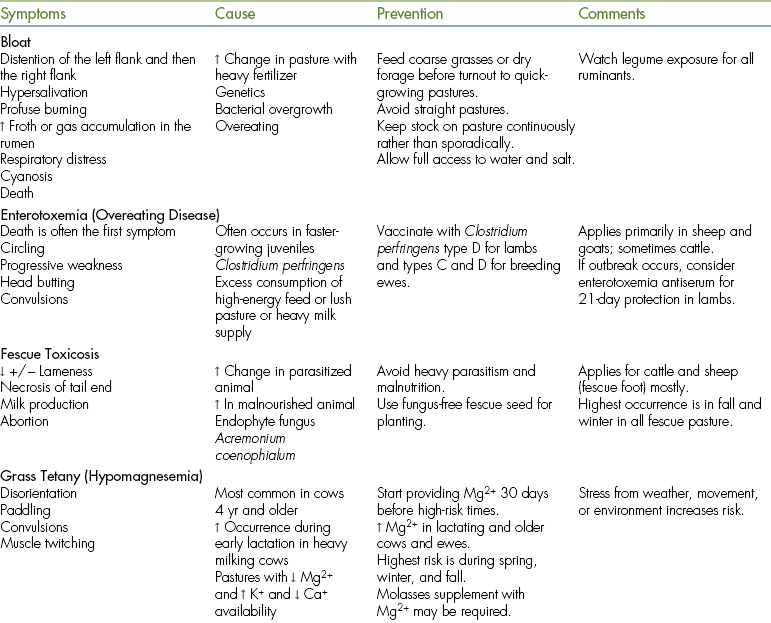
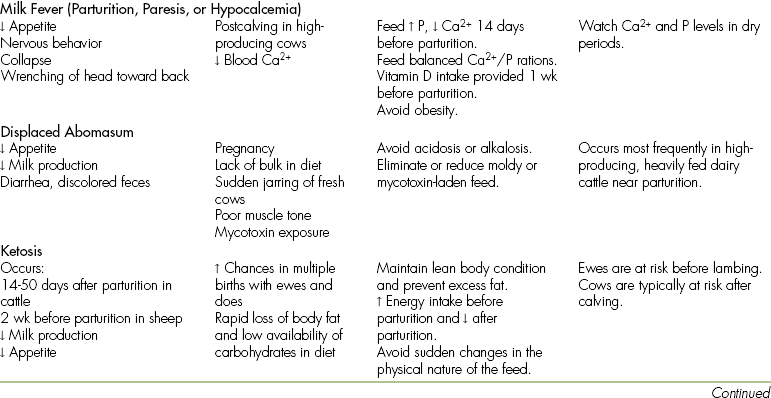

 TECHNICIAN NOTE
TECHNICIAN NOTE